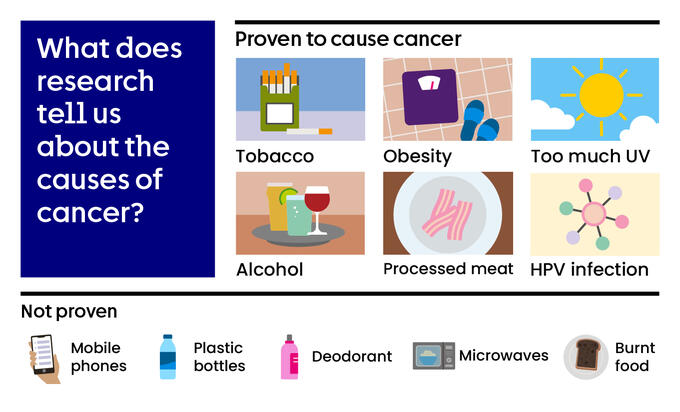Do mobile phones or Wi-Fi cause cancer?
- Mobile phones and networks (4G and 5G) do not cause cancer. Wi-Fi does not cause cancer.
- Radiofrequency radiation is too weak to be able to cause cancer by damaging DNA
- Research continues to monitor the safety of mobile phones and signals, in case of any long-term health effects
Why are some people worried about mobile phones and cancer?
We often hold our phones to our heads, or keep them close by in pockets or bags. Some people are worried that the radiation from mobile phones can cause cancer, especially brain cancer. Or that keeping phones in a bra will lead to breast cancer.
But the type of radiation that mobile phones and phone masts use doesn’t have enough energy to cause cancer by damaging DNA.
What does the research say about mobile phones and cancer?
Using mobile phones does not increase your risk of cancer.
Mobiles use a type of electromagnetic radiation called radiofrequency radiation (radio waves). It's a weak form of radiation, the same type that radios, televisions and microwave ovens produce. Radio waves do not have enough energy to damage DNA. So there’s no good explanation for how radio waves could cause cancer.
Some studies claim that mobile phones could increase cancer risk. But a lot of these studies are in animals, and some use unrealistically high levels of radiation. So they cannot reliably tell us about cancer risk from mobile phones in the real world.
When looking at the biggest studies of people and mobiles there is no consistent association between mobile phone use and cancer. Overall, there’s no reliable evidence from studies of people that mobile phones increase the risk of cancer.
What about 4G and 5G and cancer?
There is also no reliable evidence that 4G and 5G mobile networks cause cancer. Phone masts that transmit mobile signals (mobile base stations) use the same radiofrequency radiation as mobile phones.
Although 4G and 5G mobile networks are higher energy than older networks, it’s still not enough energy to damage DNA.
As mobile phones and signals are still relatively new, research in this field is ongoing in case of any long-term health effects.
Does wireless technology like Wi-Fi or Bluetooth cause cancer?
No, Wi-Fi and Bluetooth don’t cause cancer. Wireless technologies and services also use radio waves.
There’s no evidence to suggest that wireless technology increases cancer risk. This includes things like fitness trackers, smart watches and wireless headphones too.
What are the proven causes of cancer?
There are many myths, questions and hot topics when it comes to cancer risk. But thanks to decades of research into preventing cancer, we know proven ways you can lower your risk.
These include not smoking, keeping a healthy weight, staying safe in the sun, cutting down on alcohol and eating a healthy, balanced diet.
We used many references to produce this information and it is not possible to list them all here. These are the key references with a short explanation of each one:
Monograph 102: Non-Ionizing Radiation, Part 2: radiofrequency electromagnetic fields
International Agency for Research on Cancer, 2013.
This research evaluated whether radiofrequency radiation is carcinogenic (cancer-causing) to humans. It found the evidence for glioma (a type of cancerous brain tumour) is limited. A causal link between radiofrequency radiation and glioma was not shown.
K Karipidis and others, Environment International, 2024
This study looked at the results of 63 different studies and didn’t find an association between radiofrequency radiation and an increased risk of various brain cancers or childhood leukaemia.
ICNIRP Guidelines: radiofrequency electromagnetic fields (100 KHz to 300 GHz)
International Commission on Non-Ionizing Radiation Protection, 2020. [accessed November 2024]
The ICNIRP is a non-governmental international organisation and their guidelines inform the UK Government. Radiofrequency radiation is unlikely to be associated with adverse health effects, including cancer.
Last reviewed: 20 December 2024
Next review due: 20 December 2027



